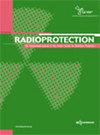Assessing optical radiation exposure to opaque incandescent materials by picture analysis – Part 1: from pixel color to radiance
IF 1.4
4区 医学
Q4 ENVIRONMENTAL SCIENCES
引用次数: 0
Abstract
In industrial processes, working on incandescent materials exposes workers to optical radiations that can lead to cataract. In the case where risk cannot be appraised using software simulation, it is necessary to measure visible and near infrared irradiance at the eye of the worker. Since radiometers and spectroradiometers are too expensive for most people in charge of safety at work, a novel method is proposed that assesses irradiance using a photograph taken by smartphone, for example. It consists in summing the irradiance corresponding to each pixel representing the opaque incandescent materials in the picture. Pixel irradiance is assessed from the radiance of the colored body whose temperature and emissivity correspond to the pixel color, weighted by the geometric configuration associated with the pixel in the camera perspective. This virtually free method is accurate enough to assess cataract risk, thereby helping employers to choose an efficient means of protecting workers. In this paper, we present the first principle of the method proposed: temperature and emissivity estimation of incandescent materials. Certains procédés industriels exposent les salariés au risque de cataracte due aux radiations optiques reçues de matériaux portés à incandescence. Si ce risque ne peut être évalué par simulation informatique, l’éclairement dans le visible et le proche infrarouge doit être mesuré au niveau de l’œil du travailleur. Radiomètres et spectroradiomètres étant trop onéreux pour la plupart des préventeurs, une méthode nouvelle est proposée pour évaluer cet éclairement sur la base d’une image du poste de travail, telle que peuvent en fournir les smartphones. La méthode additionne pour tous les pixels associés à une matière incandescente opaque dans l’image, le produit de la luminance d’un corps coloré dont la température et l’émissivité le font correspondre à la couleur du pixel, par le facteur de forme associé au pixel selon la perspective de la caméra. Cette méthode virtuellement gratuite se révèle assez précise pour évaluer le risque et aider l’employeur à prendre les mesures de sécurité adéquates. Cet article présente le premier principe de la méthode : comment estimer la température et l’émissivité des matériaux incandescents.通过图片分析评估不透明白炽灯材料的光辐射暴露 - 第 1 部分:从像素颜色到辐射度
在工业生产过程中,操作白炽灯材料的工人会受到可能导致白内障的光学辐射。在无法使用软件模拟评估风险的情况下,有必要测量工人眼睛的可见光和近红外辐照度。由于辐照度计和光谱辐射计对于大多数负责工作安全的人来说过于昂贵,因此提出了一种新方法,例如使用智能手机拍摄的照片来评估辐照度。该方法是将照片中代表不透明炽热材料的每个像素对应的辐照度相加。像素辐照度是根据温度和发射率与像素颜色相对应的有色体的辐照度来评估的,并根据相机视角中与像素相关的几何构造进行加权。这种几乎免费的方法足以准确评估白内障风险,从而帮助雇主选择保护工人的有效方法。在本文中,我们介绍了所提方法的第一个原理:白炽材料的温度和发射率估算。某些工业生产过程中,工人有可能因白炽材料的光辐射而患上白内障。如果这种风险无法通过计算机模拟进行评估,则必须测量工人眼睛的可见光和近红外照度。由于辐照度计和光谱辐射计对于大多数预防专家来说过于昂贵,因此提出了一种新方法,根据工作站的图像(如智能手机提供的图像)来评估照度。对于图像中与不透明炽热材料相关的所有像素,该方法将温度和发射率使其与像素颜色相对应的彩色体的亮度乘积,根据相机视角与像素相关的形状系数相加。事实证明,这种几乎免费的方法足以准确评估风险,并帮助雇主采取适当的安全措施。本文介绍了该方法的第一个原理:如何估算白炽材料的温度和发射率。
本文章由计算机程序翻译,如有差异,请以英文原文为准。
求助全文
约1分钟内获得全文
求助全文
来源期刊

Radioprotection
ENVIRONMENTAL SCIENCES-PUBLIC, ENVIRONMENTAL & OCCUPATIONAL HEALTH
CiteScore
3.30
自引率
54.50%
发文量
35
审稿时长
>12 weeks
期刊介绍:
Radioprotection publishes articles on all aspects of radiological protection, including non-ionising as well as ionising radiations. Fields of interest range from research, development and theory to operational matters, education and training. The very wide spectrum of its topics includes (theoretical and practical aspects): dosimetry, instrument development, specialized measuring techniques, epidemiology, biological effects (in vivo and in vitro) and risk and environmental impact assessments.
 求助内容:
求助内容: 应助结果提醒方式:
应助结果提醒方式:


